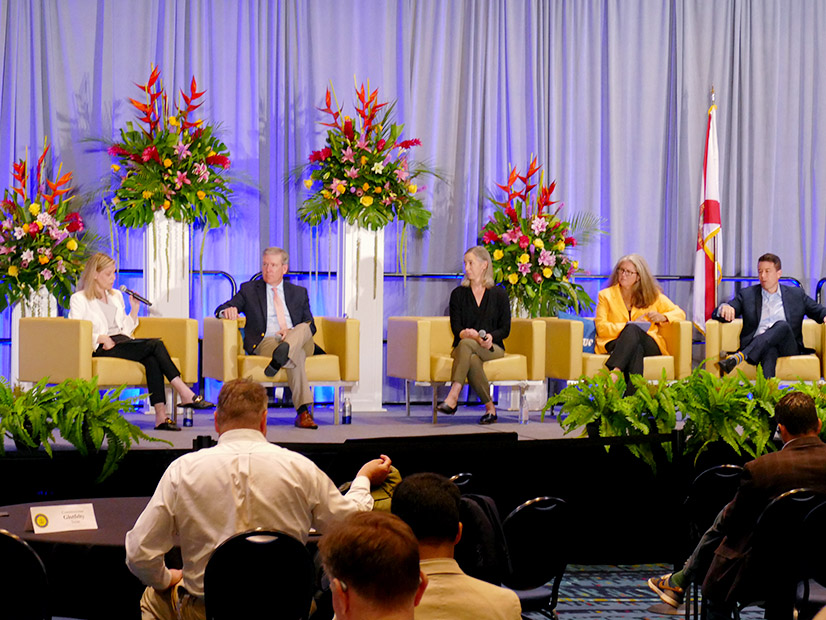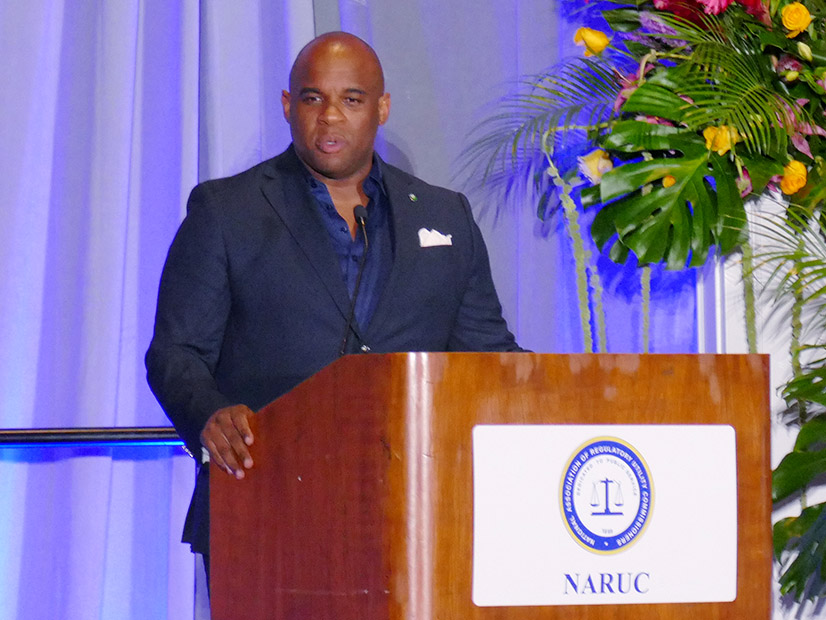
WEST PALM BEACH, Fla. — The return to demand growth in the electric power industry has been a major theme this year, and it dominated the discussion at the National Association of Regulatory Utility Commissioners’ Summer Policy Summit last week.
“We’re hearing more and more about the increase of load and demand on our system every day,” FERC Chair Willie Phillips said. “Not just regular run-of-the-mill increases. … We’re talking about sharp, material increases on our system.”
The issue varies regionally, with some areas already feeling a tighter supply-and-demand balance because of the growth in data centers, reshoring of manufacturing, electrification of home heating and transportation, and increasingly extreme weather, Phillips said.
Thousands of Houston-area customers were without power for a week at the peak of summer after Hurricane Beryl, while other parts of the country were facing major heat waves, with D.C. seeing triple-digit temperatures as NARUC was meeting.
Conservative estimates have demand growing nationally about 1%/year, which over the next five years could add up to 5,000 TWh of new demand. FERC has issued a series of major rules, including Order 2023 on interconnection and Order 1920 on transmission planning and cost allocation, that Phillips said would help the situation. Order 1920 will help expand transmission to deal with those new drivers of demand while maintaining reliability and affordability, he said.
“I know that not every commissioner in this room has embraced Order No. 1920, or 1977,” Phillips said. “Not every commissioner on FERC has embraced No. 1920.”
But the industry needs to start moving forward on planning for the future, as demand is growing, and Phillips said the order’s focus on long-term planning with a broad set of benefits will get much-needed steel in the ground.
“We have to consider grid-enhancing technologies as well,” Phillips said. “So, there is a requirement both in Order Nos. 2023 and 1920 to consider grid-enhancing technologies as we build out our system.”
Order 1920 was the subject of dissent from FERC Commissioner Mark Christie, whom Phillips called his friend from before their time as federal regulators. Phillips was on the D.C. Public Service Commission when Christie was on the Virginia State Corporation Commission, and the two neighboring state regulators regularly worked together at NARUC and the regional Mid-Atlantic Conference of Regulatory Utilities Commissioners.
Christie spoke at the conference after Phillips, and he basically agreed on the dominant theme of the event, though he framed it as reliability and said it was the states — much more so than FERC, or the ISOs and RTOs — that had the power to ensure it going forward. FERC does oversee reliability standards for the bulk power system, but it has limited authority when it comes to actually building needed infrastructure.
Section 215 of the Federal Power Act says FERC has no authority to order the construction of any utility asset, whether generation or transmission, Christie said.
“That’s the states; you are the IRP [integrated resource plan] planners,” he added. “When it comes to resource adequacy … that’s under state jurisdiction. You’re the ones who decide what generator units are going to get built. You’re the ones who decide what generator units are ultimately going to be retired.”
RTOs’ primary role is to run the system and to make sure they can balance the grid, which is important. The organized markets will say when they see trouble brewing on the reliability front; Christie said many of their communications on those lines in recent years showed a brewing crisis for the grid.
“Yesterday at 4:30, PJM peaked on this hot day; PJM peaked at about 153 GW of load. … They had 9 GW in reserve. That’s 6%,” Christie said July 16.
July 15 was one of the hottest days of the year, and despite PJM using almost all its generation to meet the day’s demand, the RTO is expecting to lose up to 50 GW in the coming years, Christie said. “That arithmetic does not work.”
Other RTOs are also forecasting retirements and seeing thinner reserve margins, which Christie said is a recent phenomenon. For most of his tenure on the SCC, Virginia’s utilities would come in with load growth projections that nobody believed because they were always flat from the previous data, and the numbers were coming at a time when PJM was very long on capacity.
That changed toward the end of Christie’s tenure at the SCC and has continued during his tenure on FERC. Virginia has been home to “Data Center Alley” for decades, and while that used to be focused around the D.C. area, it has stretched down I-95 to Richmond in recent years, Christie said.
“When you are doing load forecasts now, you’ve got to really get those things right,” Christie said. “And then you’ve got to take seriously what they are showing.”
Demand Growth Projections
Grid Strategies President Rob Gramlich presented his organization’s report released late last year about the change in demand growth trends. (See Grid Planners Predict Sharp Increase in Load Growth.)
The five-year load growth forecast doubled in one year, Gramlich said, with some regions like Dominion Virginia Power and ERCOT seeing higher load growth than the average. The new load is coming from reshoring manufacturing, data centers and electrification. Data centers alone may contribute 1% demand growth annually.
Addressing that demand growth will require enhancing the distribution and transmission systems, as well as ensuring the grid has enough energy around the clock and important reliability services like inertia and ramping, Gramlich said.
While 1% load growth does not sound like that much, it is double what had been the norm in recent years, and over time, it can really add up, said former FERC Commissioner Tony Clark, senior adviser at Wilkinson Barker Knauer. The numbers also vary significantly by region.
“This is a paradigm shift that is probably perhaps not unlike the paradigm shift we saw with fracking and availability of natural gas in terms of impact on the industry itself,” Clark said. “So, it’s a big deal.”
The new demand growth is coming at a time of traditional generators retiring, and the replacements tend to be renewables, which offer plenty of energy, but not nearly the same amount of capacity as traditional power plants, Christie said.
Clark brought up the same issues about replacing retiring generation, and he argued that no “silver bullet” exists to deal with the projected gap as demand grows.
“In all probability, to me, it looks like probably some sort of mix of natural gas and renewables in the near-term future because that’s what we have available today,” Clark said.
Other options, like long-term storage, small modular reactors or other kinds of advanced nuclear, are not immediately available, so serving the demand reliably is going to be a real challenge, he added.
The Impact of Vehicle Electrification
While forecasts always carry uncertainty, some of the load growth is already baked in, with Alliance for Automotive Innovation CEO John Bozzella saying California’s rules on vehicle mileage, which have been adopted by states representing 40% of the market, will require 35% of their vehicles be electric in the coming years.
But many consumers have started to sour on electric cars because charging infrastructure has not kept up with demand. According to AAI’s latest report, as of the first quarter this year, the U.S. had 167,213 chargers for 4.7 million electric vehicles, for a ratio of 28 to 1, while 1 million are needed by 2030 to meet projected demand.
McKinsey & Co. has found that 46% of current owners are likely to switch back to gas-powered vehicles (compared to 29% globally), and the biggest reason is the lack of public chargers, Bozzella said.
The impact on the grid of electrifying medium- to heavy-duty vehicles represents much bigger loads. Environmental Defense Fund Attorney Cole Jermyn said fleet managers are planning to transition a year or two ahead of time, which is shorter than most utility planning cycles.
“If they’re a large fleet, that’s a multi-megawatt load that, depending on the grid infrastructure, can take several years — well longer than the fleet actually knows their plan — to complete the substation, the feeder or transformers, or whatever it is that they need to actually bring their chargers online,” Jermyn said. “So, … the pace of the electrification is creating this disconnect that requires proactive efforts to prepare for.”
It is possible for utilities to proactively plan for major fleet electrification because they are in specific neighborhoods, whereas light-duty vehicles are spread around utility territories, he added.
While estimates vary for how quickly both consumers and businesses will electrify their vehicles, even the low-end predictions represent significant new loads, said Ben Shapiro, manager of RMI’s Carbon-Free Transportation team.
“Utilities understandably want to be sure, to the extent possible, that they’re going to get cost recovery,” Shapiro said. “And they don’t have a ton of incentive to be more proactive in this space under the existing paradigm.”
That requires reducing the uncertainty to improve decision-making, shifting to a more targeted approach to addressing future load growth, and finding new ways to mitigate and share risk across parties, he added.
One area that can help improve load forecasting is “vehicle telematics” that show utilities where fleets are driving and parking now to inform future charging needs, Shapiro said. Another policy that would help is ensuring that the existing infrastructure is used efficiently to help avoid overbuilding distribution system upgrades.
The federal Joint Office of Energy and Transportation, which combines the efforts of both departments on the transition to EVs, has a plan to start working on expanding electrification around the country, said Jean Chu, an analyst for the office.
“Our intention is to capitalize public and private investment to accelerate the industry activity and to signal the utility and electric utility and hydrogen market to plan and deploy the necessary generation, transmission and distribution projects,” Chu said.
The plan would prioritize areas likely to be early adopters of medium- and heavy-duty vehicle electrification first, and then link those regions together along the existing highway network. Once the biggest areas are connected in the next decade, the departments would shift their focus to electrifying the rest of the country, Chu said.
Data Center Expansion
Constellation Energy has the largest competitive retail business serving the commercial-and-industrial sector, but Chief Strategy Officer Kathleen Barrón said they do not have any better idea of what future demand will be than others presenting at NARUC.
Hydrogen was supposed to be a major driver of load growth, but issues around tax credits have at least delayed that, and the shift toward electrification has also waned in recent years. Now the latest issue is data centers scaling up as new technologies require more capacity from them. The Electric Power Research Institute released a report on data centers recently, and its forecasts vary widely, Barrón said. (See EPRI: Clean Energy, Efficiency Can Meet AI, Data Center Power Demand.)
“Some of the developers are looking at different sites for the same project, so I think that they contribute to a little bit of double counting,” Barrón said.
Data center developers are taking a page from the renewable industry, where they propose multiple projects to find out where it is cheapest to plug into the grid, with more expensive alternatives never coming to fruition.
“But in general, of course, we do see greater load growth moving forward than we have historically,” Barrón said. “So the question is, how do customers plan to meet that demand? What we’re seeing is an increasing number of them looking to power their operations with zero-carbon electricity.”
Policies are pushing the industry cleaner, but many large data center customers want to go even further and power their operations with 24/7 clean electricity, she added. Constellation can meet their demands in a variety of ways, including linking multiple large customers as off-takers under power purchase agreements with new renewables, and it also owns and operates the largest domestic fleet of nuclear reactors.
The demand for data centers needs to be met with states offering incentives to site them in their jurisdictions and the federal government seeing the issue of artificial intelligence technology as a key national security issue, Barrón said.
While AI technology is more energy intensive than traditional internet use, Briana Kobor, Google’s head of energy market innovation, noted that data centers are used every time customers surf the internet on their smartphones and are involved in huge parts of the economy generally.
“In 2020, the digital economy accounted for over 10% of U.S. GDP and [employed] nearly 8 million people,” she added.
AI might currently be dominated by chat bots and the production of “funny pictures,” but the technology could revolutionize how humanity deals with some of its biggest problems, Kobor said.

About 4% of PJM’s overall load goes to serve data centers, as it is home to a large share of the 2,700 facilities around the country, with many of them in Northern Virginia, but also other areas the grid operator serves, such as Columbus, Ohio, said Jason Stanek, the RTO’s executive director of government services.
While some of the projections could be influenced by speculative data centers, load is growing in ways that were unexpected just a few years ago. PJM is increasingly focused on figuring out exactly where the new data centers are actually going to plug into the grid, and it has surveyed the local delivery companies in its footprint to get better data in its load forecasts.
“We ask our utilities within PJM to report back whether or not we need revisions to reflect large customers coming on board,” Stanek said. “The question is whether or not these data centers are shopping around; we’ll see multiple data centers show up.”
The data PJM gets back from its member utilities will be included in a new forecast that is released in January 2025, he added.
Google agrees that there is likely some duplication in the amount of data center demand being projected, and it is important to get the numbers right; as a customer it wants to avoid overbuilding the system, Kobor said.
“We have a shared interest in making sure that we do not end up with an overbuilt system and get stranded costs at the end of this, just like any other ratepayer,” she added. “So I encourage folks to continue that conversation with us as we continue down this journey. And I think we are likely in a point of greatest uncertainty, and we’re going to start to see greater clarification as we move forward.”
Getting that clean supply from the grid can be complicated for data centers, which have a shorter development time than it takes to build new generators, interconnect them to the grid and expand transmission to deliver new power to load, Barrón said. That has driven interest in data centers and other large customers to link up directly to nuclear plants and avoid using the grid altogether.
The issue of data centers connecting directly at nuclear plants is pending in a case at FERC, in which Constellation has intervened to argue that the commission should let such deals happen — though others have said it could bring up issues around cost shifting and eventually even reliability. (See Talen Energy Deal with Data Center Leads to Cost Shifting Debate at FERC.)
Locating at nuclear plants also avoids “NIMBYism” because they are always built on large swaths of land. Such deals also avoid building out the transmission and distribution systems to accommodate major new loads, avoiding socializing those costs to other customers.
Nuclear plants benefit from a tax credit that has prevented more retirements, but that is going to sunset in eight years, and forecasters expect nuclear retirements will resume when it does, Barrón said.
“If you have a customer that was willing to commit to long term, you wouldn’t have to be concerned about that,” she added.




